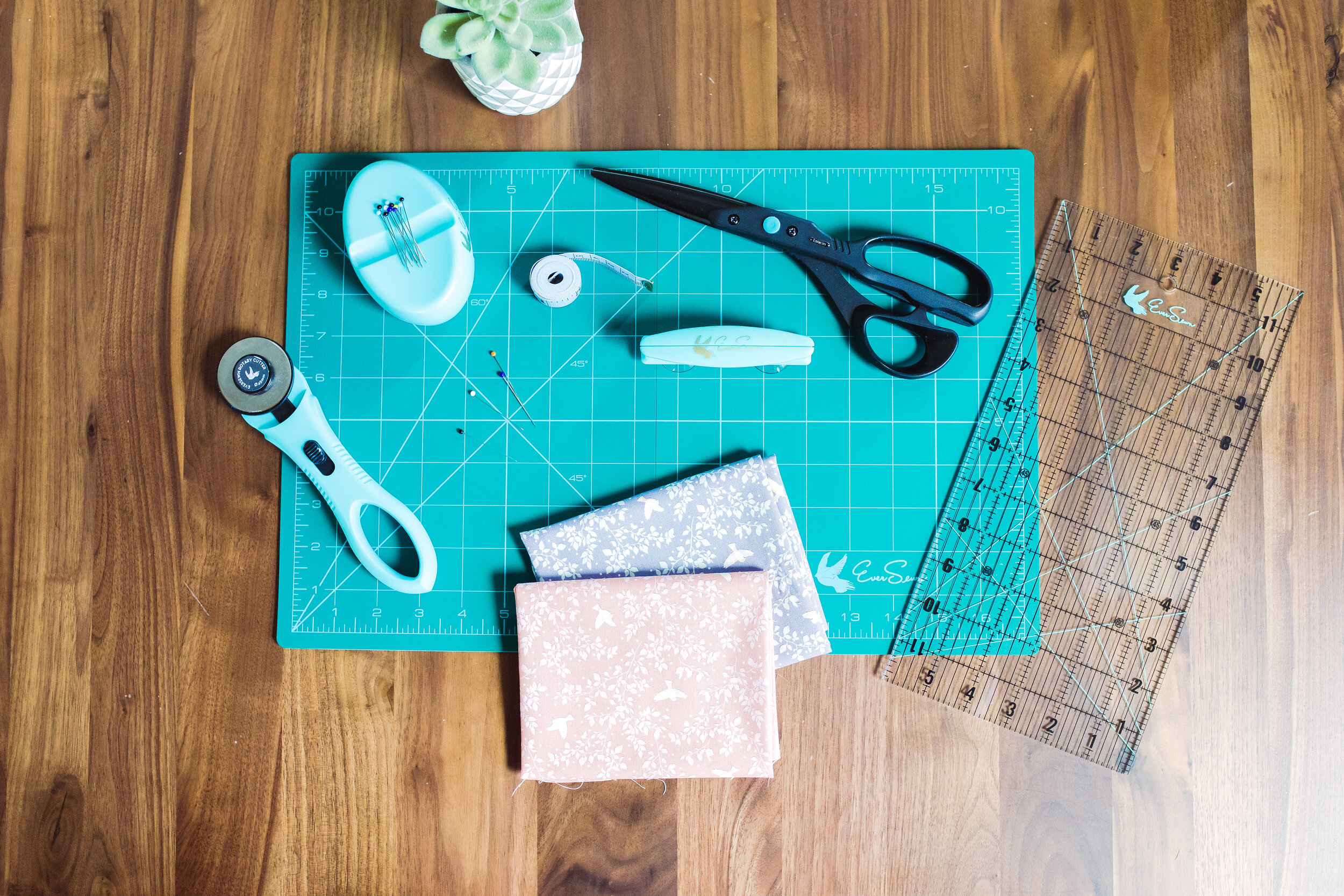Make Space to Create
/The crafting community is diverse and broad. The maker movement and cottagecore aesthetic of the last few years have brought attention to what it’s possible to make with your own two hands (and the right tools, of course!), and EverSewn has taken note! We respect the kitchen table sewists, the office/guest room/craft room creators, and we envy the she-shed owners.
No matter what your craft space looks like, we want to offer some pointers and helpful organization tools to keep in mind as you design (or maybe redesign) your crafting layout!
First, we want to introduce you to a few EverSewn products that can make your space more efficient. Then Daniela Gonzalez from Porch will talk about utilizing whatever space you have in the best way possible!
The Tools Don’t Make the Maker - But They Sure Help!
When sewing, you’ve got your machine, thread, scissors, rotary cutter, cutting mat, and, of course, your fabric stash and a million other necessary notions! Without a doubt, one of the most awkward items to store is your cutting mat. You know they’re supposed to be stored flat, but who has a giant, flat space to stash a cutting mat? We feel your pain, so we made a foldable cutting mat! The folds are seamless and the mat is extremely durable.
Another thing that drives us up the wall when we’re sewing is loose bobbins! Especially when you go to all the work to pre-wind bobbins in your most-used colors and then can’t find them. Oh, the annoyance. We’ve been there. Grab yourself a bobbin nest (or a few…) and tame that stash of threaded bobbins!
Okay, we’ve solved the awkward cutting mat storage conundrum, we’ve got your bobbins all pulled together, but what to do when you need to put it all away (including your machine)? Or travel with all your sewing goodies? Again, EverSewn has you covered. Our spacious rolling tote has all the room for your machine plus sewing necessities. Our staffers who don’t have a dedicated craft space love using this tote to store their crafting supplies until the next time they take over the dining room table!
If these handy items are calling your name, head over to our store locator and grab them for yourself or your favorite crafter!
Create Your Own Sewing Room
Daniela Gonzalez has some incredible tips on creating your own sewing space and how to make it all work for you!
Sewing is a wonderful hobby that can quickly turn into a profitable one with a bit of practice, even if you’ve never handled a needle and thread before. Those who love to sew appreciate having a dedicated space where they can hone their craft. Whether you already enjoy the art of sewing or you’re ready to learn how to do it, it’s essential to have an area where you can set up your sewing machine and accessories. From custom clothing to crafts, sewing is a profitable hobby that continues to stand the test of time. Read on to learn a few sewing 101 tips and some information about how you can create your sewing room at home.
Sewing for Beginners
Learning to sew takes time and patience, but it can certainly pay off once you know the proper techniques. You can sew some things by hand, but if you’re serious about sewing larger items and doing it more frequently, you’ll want to purchase a sewing machine. A good sewing machine can cost anywhere from $99 to up to $2,000 or more. Consider your skill level, how much space you have, and your budget before purchasing a new machine. You’ll also want to stock up on accessories, including plenty of needles in different sizes, various colors of thread, fabric, a quality pair of scissors (or two), and pins. Make sure you gather everything together before you start sewing, so everything you need is close at hand.
Sewing Techniques: Sewing involves lots of terminologies, many regarding a specific sewing technique. Beginners can start with simple, straight-line stitching while learning how to sew a seam or sew two fabric pieces together. However, there are plenty of other techniques involved for more complicated projects like seam finishing, clipping corners, attaching appliques to garments, and sewing on buttons, to name a few. Beginners should learn the techniques of zig-zag stitching, seam finishing, and understitching before moving on to more intricate or larger projects.
Material and Fabric: Stitching styles and sewing techniques often depend on the type of fabric you’re using. While there are hundreds of fabrics out there, people new to sewing have a few basic options to choose from for their ease. Cotton is a classic staple that you’ll always want to have on-hand. Canvas is a heavy yarn fabric that’s ideal for sewing bags and pants. Softer, more luxurious fabrics include chenille, silk, velvet, crepe or georgette, and lace. You can also graduate to more complicated materials like leather, merino wool, or twill once you’re confident in your sewing skills.
Design Tips: Whether you’re sewing a pillow or a gorgeous dress, there are some important design tips to keep in mind for success. Bound seams will make anything look much more polished and professional. Sewing an “invisible zipper” gives garments and pillows a polished look. Once you gain confidence in your skills, add some decorative stitching to give your projects some flair. Learning new designs takes time and practice, so keep at it, and soon, you’ll be able to create the looks you want with ease.
Creating Your Sewing Room
Once you learn to sew, it becomes a fun, fulfilling experience. You’ll want to have the space you need to work on your newest projects at home. Create your sewing room at home with just a few simple steps, and you’ll have a dedicated spot for all of your sewing goodies — and a place where you can express your creativity.
Space and Layout
Start by choosing a dedicated space in your home for all of your sewing endeavors. It can be a spare bedroom, a nook in your living room, or even a room over the garage — or the garage itself, for that matter. Once you select your spot, draft the sewing room layout on a piece of paper. Ensure that you include where you want to put your sewing machine, work table, fabrics, and accessories. The room should get plenty of natural light or have ample lighting, so it’s easy to see while you work.
Furniture and Machinery
No sewing room is complete without a sewing machine, so make this the room’s focal point. You’ll also need a comfortable chair for sitting at the sewing machine or the table. A large table with plenty of elbow room will make it easier to layout fabrics, make cuts, and spread out all of your sewing notions. Storage furniture, like shelves or cabinets, is also vital for keeping everything neat and organized. You can even create custom cabinetry designed to store your multiple sewing projects.
Decoration and Design
Make your sewing room a special place where you feel relaxed and happy. Surround yourself with inspiration: Paint the walls your favorite color, and hang framed fashion posters or a favorite quilt on the wall. A corkboard is a great place to pin your ideas or create a mood board. Add some hooks to the wall so you can hang fabrics and grab them when you need them. Sew your custom curtains for the room — an easy beginner project — and if there’s room, bring a couch or comfy chair in where you can sit and browse through patterns or contemplate your next project.
Organization and Storage
Use storage bins with labels to help you quickly find small items. For the small stuff, a tackle box is an excellent organizer. Clear canisters or jars are perfect for buttons, and a pegboard right over your sewing machine is a great way to organize things like spools of thread and pairs of scissors. Open shelving makes it easy to find what you need — especially your fabric, creating a beautiful focal point if you keep it folded and tidy. Another stylish way to decorate your sewing room and organize your fabric stash is to roll it up and keep it in woven baskets. Suppose you’re not one to keep things super tidy; opt for a cabinet, where you can keep things organized ( not!) your way in private. The key is to group everything by type so that you can grab what you need quickly.
Maintenance
Keep your sewing room clean by putting everything away each day. Throw out stray snips of thread, yarn, or scraps of fabric that are too small to reuse. If you find that you aren’t going to use certain materials, consider donating them or giving them to a friend who enjoys sewing. Try to declutter your sewing room at least once a month, and do a standard cleaning weekly to keep everything neat and tidy.
Benefits of Sewing
Whether you’re making DIY clothes for your kids or decompressing at the end of a long day, sewing offers many benefits that will enhance your life. Here are just some of the benefits that sewing can add to your life.
Stress relief.
Anything you enjoy doing will help you feel more relaxed and calmer, especially when you get into your groove — also known as flow, which is hugely beneficial for relieving stress and anxiety. Sewing is an incredibly creative hobby that gives you a chance to nurture and express your artistic side. The feeling of accomplishment after you finish a project can be extremely fulfilling, too.
Eco-friendly Clothing/Sustainable Sewing
When you learn how to make your clothes, you’re contributing to a cleaner, greener world. Sewing your items reduces waste. It also reduces the profits of fast fashion companies that use non-sustainable practices to produce their goods. Choose eco-friendly fabric when you sew to make an even more significant positive impact.
Improvement of hand/eye coordination
Sewing is a fantastic way to improve your hand-eye coordination. This is great for cognitive development and spatial perception. Hand-sewing is even better since you will have to thread the needle and make the stitches using your hands and fingers. With regular practice, you’ll notice your hand-eye coordination start to improve.
Tailored clothing
Learning how to sew your clothes has lots of benefits, including the ability to tailor anything for a perfect fit. Whether it’s a prom dress or work clothes, you’ll be able to make everything in your closet fit you like a glove.
Saving money
A big perk to sewing is that it can save you tons of money. Instead of doling out loads of cash on the latest styles, you can make your customized wardrobe at home for a fraction of the cost. And if you have kids, you’ll save even more if you make their clothes, too. Just find a few simple patterns, buy a bunch of different fabrics you can mix and match, and whip up a year’s worth of pants, shirts, and dresses for the wee ones. You can also save money by sewing gifts, like baby blankets, placemats, or tote bags.
Whether it’s a beautiful heirloom-worthy quilt or a gorgeous blouse for next week’s soiree, you can create a wide range of textiles when you learn to sew proficiently. Having your own dedicated sewing space to work in makes it even better, giving you space entirely dedicated to nurturing your creative spirit.




